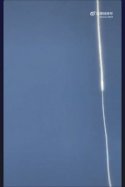You are using an out of date browser. It may not display this or other websites correctly.
You should upgrade or use an alternative browser.
You should upgrade or use an alternative browser.
Chinese Hypersonic Developments (HGVs/HCMs)
- Thread starter A.Man
- Start date
Would fitting a warhead (conventional or nuclear-tipped) and its delivery unit onto China's spaceplane that were launched recently, i.e. Shenlong be a viable option for hypersonic bombing runs?
Say, during times of ultra-hightened tensions, China could launch these spaceplane bombers into orbit, and have them circle just outside ad along the boundaries of the territorial airspace of the enemy country, like space-version of deterrence patrols.
In case war does break out with said enemy country, those spaceplane bombers can be directed to either lob their payload outside of the territorial airspace of the enemy country and let those payload fall towards its target, or adjust their course and have them drop their payloads close to their targets within the boundaries of the enemy country's territorial airspace.
Such deterrence patrols would be akin to Operation Chrome Dome undertaken by the USAF in the 1950s and 1960s where they flew nuclear-armed bombers along the Soviet borders, and would be able to fly towards and drop nuclear weapons onto their targets at a moment's notice. But of course, this spaceplane bomber-version of Operation Chrome Dome would only be deployed during periods of hightened tensions, and are capable of much higher chances of warhead penetration rates compared to their American counterparts 60 years ago.
It would be better to send those same weapons without the spaceplane. Spaceplane's extra weight with re-entry thermal protection, lifting surfaces, landing gear etc in exchange can get a lot more tonnage of weapons into orbit.
Each individual weapons need their own guidance and propulsion anyway so you don't need the spaceplane. Putting them all inside the spaceplane also makes it an easy target for enemy ASAT weapon. I'd rather send a bunch of weapons up there and disperse them, if the enemy is to shoot them down they better expense a bunch of ASAT weapons doing so, against decoys as well.
Using a spaceplane has one big advantage, which is less predictable and more difficult to intercept payloads. Trying to figure out how to intercept a hypersonic missile that is being launched from a carrier that is also flying hypersonic, and likely firing at *much* closer range to it target of interest, is going to be far more difficult than trying to intercept a hypersonic missile launched from the surface at much further ranges, flying with a much more constrained and predictable range of trajectories.It would be better to send those same weapons without the spaceplane. Spaceplane's extra weight with re-entry thermal protection, lifting surfaces, landing gear etc in exchange can get a lot more tonnage of weapons into orbit.
Each individual weapons need their own guidance and propulsion anyway so you don't need the spaceplane. Putting them all inside the spaceplane also makes it an easy target for enemy ASAT weapon. I'd rather send a bunch of weapons up there and disperse them, if the enemy is to shoot them down they better expense a bunch of ASAT weapons doing so, against decoys as well.
The point of launching a hypersonic missile from a spaceplane is the same as deploying your weapon in the orbit. It is an idea that everybody want, USSR and US had the idea of satellite based, but that means you can never bring them back. It is a serious problem since most likely the payload is nuclear, you do want to bring them back safely if you decided to stop the attack. The space shuttle was intended for that purpose, otherwise why would the US military pay for it. It is a lousy vehicle for satellite launching, but a good space bomber.
Anyways, the idea is that a space plane can carry missiles flying in orbit having multiple launch windows (every hour or 2) everyday. When the warhead is released and deorbited it takes much shorter time (only the reentry time) to hit the target, there is no detection at accent stage, no interception in midcourse like a ICBM. There is only de-orbit burns of small thrusters, there is no way to detect that even if you are constantly watching it.
Anyways, the idea is that a space plane can carry missiles flying in orbit having multiple launch windows (every hour or 2) everyday. When the warhead is released and deorbited it takes much shorter time (only the reentry time) to hit the target, there is no detection at accent stage, no interception in midcourse like a ICBM. There is only de-orbit burns of small thrusters, there is no way to detect that even if you are constantly watching it.
Using a spaceplane has one big advantage, which is less predictable and more difficult to intercept payloads. Trying to figure out how to intercept a hypersonic missile that is being launched from a carrier that is also flying hypersonic, and likely firing at *much* closer range to it target of interest, is going to be far more difficult than trying to intercept a hypersonic missile launched from the surface at much further ranges, flying with a much more constrained and predictable range of trajectories.
For an orbital spaceplane like Shenlong or X-37 it's unpredictability comes from random orbital maneuver which expend delta-V, a weapon with its own propulsion can do the same and has much better mass ratio thus more delta-V due to not having to lug around a lot of dead weight.
If you're talking about something like a bomber version of Tengyun or some sort of wave-rider hypersonic glider then it might have some advantages.
I am talking about a bomber.For an orbital spaceplane like Shenlong or X-37 it's unpredictability comes from random orbital maneuver which expend delta-V, a weapon with its own propulsion can do the same and has much better mass ratio thus more delta-V due to not having to lug around a lot of dead weight.
If you're talking about something like a bomber version of Tengyun or some sort of wave-rider hypersonic glider then it might have some advantages.
It looked like 2 different types of contrail and a transition between the two is visible. Possibly the result of transition to scramjet.
Well spotted. You're right. There is a few frames showing two distinct contrail sections.


The contrail being "left behind" looks like typical rocket contrail while the newer one that's brighter and seemingly not as effected by turbulence is perfectly straight. Could be combined cycle engine or rocket booster being separated and another propulsion kicking in. But since the transition is immediate, I lean towards combined cycle. Booster section jettisoned should have a small but clear gap between different contrails.
by78
General
Some news blurbs released recently by Xi'an Aerospace Power Research Institute mention successful tests a scramjet project. Progress has been steady, and they've been able to achieve a test duration of 1000 seconds.




7月22日,西安航天动力试验技术研究所四个试验中心首次实现“一日六试”,一日之内圆满完成了液氧煤油发动机、姿轨控发动机、超燃冲压发动机等三种类型、六个型号的航天液体动力试验任务,高质量保证成功、数字化研发、适应批量生产及新型动力研发等试验验证能力提升效果显著。
On July 22, the four test centers of Xi'an Aerospace Power Test Technology Research Institute realized "six tests a day" for the first time, and successfully completed three types of liquid oxygen kerosene engines, attitude and orbit control engines, and scramjet engines within one day.




Some news blurbs released recently by Xi'an Aerospace Power Research Institute mention successful tests a scramjet project. Progress has been steady, and they've been able to achieve a test duration of 1000 seconds.




The test duration of 1000 seconds of the scramjet sounds like a substantial improvement over the previously published record of 600 seconds over two year ago.
A team led by Fan Xuejun at the Institute of Mechanics under the Chinese Academy of Sciences has developed a type of scramjet that ran continuously for 600 seconds in a ground test, Weihutang, a program on military affairs affiliated with state broadcaster China Central Television (CCTV), reported on over the weekend.
This broke the world record of 210 seconds set by the US' X-51 aircraft, Weihutang said.
Prompt Global Strike
